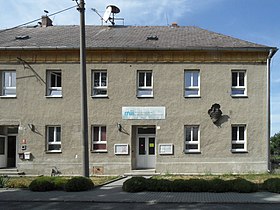Muzeum izolace, internace a integrace
 Museum building |
|
| Data | |
|---|---|
| place | Městys Bílá Voda |
| Art |
Local museum
|
| opening | 2012 |
| Website | |


The Muzeum izolace, internace a integrace ( miii ) - translated Museum of isolation, internment and integration - located in the district of Městys Bílá Voda the municipality Bílá Voda in the Czech Republic .
location
The museum is located in house number 68 on the Ring in the former town hall of the market town of Weißwasser .
history
After the last sisters left the former internment camp in the Bílá Voda monastery at the beginning of the 21st century, the film director Marek Dušák developed the idea of setting up a museum to document the rich and eventful history of the community in 2002. The idea was supported by the Starosta Miroslav Kocián, but the community did not have the means to implement it. In 2011, the municipal representatives decided to apply for funding from the rural development program of the State Agricultural Intervention Fund. The historian Michaela Neubauerová from the Jeseník Museum was able to be won over to develop the project . September 7, 2012 - the birthday of the first Rector of the Weißwasser Piarist High School Damasus Brosmann (1731–1798) - was selected as the opening date. Was developed at that time also a list of as part of the action K from 1950 in Bila Voda 1000 Sisters interned in 14 orders and congregations, the monasteries of between Jiřetín and Prešov came. The Archbishop of Prague Dominik Duka was won as patron .
exhibition
The expositur is divided into two areas.
The first room is dedicated to the local history of the legendary pagan burial place Bilawoda with a pagan idol, ascribed to around 1000, the settlement of Preseka in the 13th century and the once again extinct village of Wyssoka, as well as the development of the village of Weißwasser , which can be traced back to 1532 and which was founded in 1748 by the Bohemian Queen Maria Theresa , the lower part of Weißwasser became a market town and its heyday in the 18th century, as well as the expulsion of the German residents after the Second World War and the beginning of isolation as a result of the border closure with Poland.
In the other room, the history of the Bílá Voda nuns' internment camp, which existed during communist rule between 1950 and 1989, is presented.
Individual evidence
Web links
Coordinates: 50 ° 26 ′ 33 ″ N , 16 ° 55 ′ 3 ″ E